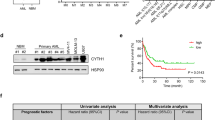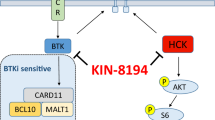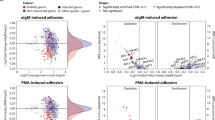Abstract
Integrin-mediated cellular adhesion to extracellular matrix (ECM) components is an important determinant of chemotherapeutic response of human myeloma cells. Here, we demonstrate that when K562 chronic myelogenous leukemia (CML) cells are adhered to fibronectin (FN), they become resistant to apoptosis induced by the BCR/ABL inhibitors AG957 and STI-571, as well as DNA damaging agents and γ-irradiation. This phenomenon, termed cell adhesion-mediated drug resistance (CAM-DR), was induced by adhesion through the α5β1 (VLA-5) integrin. Phosphotyrosine analysis demonstrates that anti-apoptotic signaling through integrins in K562 cells is independent of the tyrosine kinases activated by BCR/ABL, with the possible exception of an unknown 80 kDa protein. Cytoprotection of FN-adhered CML cells indicates that tumor–ECM interactions may be critical for the emergence of drug-resistant tumor populations and treatment failure in this disease. Antagonists of β1 integrin-mediated adhesion or corresponding signal transduction elements may sensitize CML cells to chemotherapy and prevent resistance to the novel BCR/ABL kinase inhibitors being used for the treatment of this disease.
This is a preview of subscription content, access via your institution
Access options
Subscribe to this journal
Receive 12 print issues and online access
$259.00 per year
only $21.58 per issue
Buy this article
- Purchase on SpringerLink
- Instant access to full article PDF
Prices may be subject to local taxes which are calculated during checkout







Similar content being viewed by others
References
Meredeth JE, Fazeli B, Schwartz MA . The extracellular matrix as a cell survival factor Mol Biol Cell 1993 4: 953–961
Bates RC, Buret A, van Helden DF, Horton MA, Burns GF . Apoptosis induced by inhibition of intercellular contact J Cell Biol 1994 125: 403–415
Damiano JS, Cress AE, Hazlehurst LA, Shtil AA, Dalton WS . Cell adhesion mediated drug resistance (CAM-DR): role of β1 integrins and resistance to apoptosis in human myeloma cell lines Blood 1999 93: 1658–1667
Damiano JS, Dalton WS . Integrin-mediated drug resistance in multiple myeloma Leuk Lymphoma 2000 38: 71–81
Sethi T, Rintoul RC, Moore SM, MacKinnon AC, Salter D, Choo C, Chilvers ER, Dransfield I, Donnelly SC, Strieter R, Haslett C . Extracellular matrix proteins protect small cell lung cancer cells against apoptosis: a mechanism for small cell lung cancer growth and drug resistance in vivo Nat Med 1999 5: 662–668
Lundell BI, Mc Carthy JB, Kovach NL, Verfaillie C . Activation of beta1 integrins on CML progenitors reveals cooperation between beta1 integrins and CD44 in the regulation of adhesion and proliferation Leukemia 1997 11: 822–829
Schofield KP, Duerig J, Rushton G, Chang J . alpha4beta1 integrin-mediated adhesion of CD34+ cell from patients with chronic myeloid leukemia: influence of IL-3 Br J Haematol 1999 106: 524–527
Deisseroth AB, Zhifei Z, Claxton D, Hanania EG, Siquing F, Ellerson D, Goldberg L, Thomas M, Janiceck K, Anderson WF, Hester J, Korbling M, Durett A, Moen R, Berenson R, Heimfeld S, Hamer J, Calvert L, Tibbits P, Talpaz M, Kantarjian H, Champlin R, Redding C . Genetic marking shows that Ph+ cells present in autologous marrow of chronic myelogenous leukemia (CML) contribute to relapse after autologous bone marrow transplants in CML Blood 1994 83: 3068–3076
Leemhuis T, Leibowitz D, Cox G, Silver R, Srour EF, Tricot G, Hoffman R . Indentification of BCR/ABL-negative primitive hematopoietic progenitor cells within chronic myeloid leukemia marrow Blood 1993 81: 801–807
Daley GQ, Van Etten RA, Baltimore D . Induction of chronic myelogenous leukemia in mice by the P210bcr/abl gene of the Philadelphia chromosome Science 1990 247: 824–830
Gishizky ML, Witte ON . Initiation of dysregulated growth of multipotent progenitor cells by bcr-abl in vitro Science 1992 256: 836–839
McGahon A, Bissonnette R, Schmitt M, Cotter KM, Green DR, Cotter TG . BCR-ABL maintains resistance of chronic myelogenous leukemia cells to apoptotic cell death Blood 1994 83: 1179–1187
Jamieson L, Carpenter L, Biden TJ, Fields AP . Protein kinase C activity is necessary for Bcr-Abl-meidated resistance to drug-induced apoptosis J Biol Chem 1999 274: 3927–3930
Amarante-Mendes GP, Naekyung KC, Liu L, Huang Y, Perkins CL, Green DR, Bhalla K . Bcr-Abl exerts its antiapoptotic effect against diverse apoptotic stimuli through blockage of mitochondrial release of cytochrome C and activation of caspase-3 Blood 1998 91: 1700–1705
Dubrez L, Eymin B, Sordet O, Droin N, Turhan AG, Solary E . BCR-ABL delays apoptosis upstream of procaspase-3 activation Blood 1998 91: 2415–2422
Rowley PT, Keng PC, Kosciolek BA . The effect of bcr-abl antisense oligonucleotide on DNA synthesis and apoptosis in K562 chronic myelogenous leukemia cells Leukemia Res 1996 20: 473–480
Amarante-Mendes GP, McGahon AJ, Nishioka WK, Afar DE, Witte ON, Green DR . Bcl-2-independent Bcr-Abl-mediated resistance to apoptosis: protection is correlated with up regulation of Bcl-xL Oncogene 1998 16: 1383–1390
le Coutre P, Mologni L, Cleris L, Marchesi E, Buchdunger E, Giardini R, Formelli F, Gambacorti-Passerini C . In vivo eradication of human BCR/ABL-positive leukemia cells with an ABL kinase inhibitor J Natl Cancer Inst 1999 91: 163–168
Dan S, Naito M, Tsuruo T . Selective induction of apoptosis in Philadelphia chromosome-positive chronic myelogenous leukemia cells by an inhibitor of BCR-ABL tyrosine kinase, CGP 57148 Cell Death Differ 1998 5: 710–715
Druker BJ, Lydon NB . Lessons learned from the development of an Abl tyrosine kinase inhibitor for chronic myelogenous leukemia J Clin Invest 2000 105: 3–7
Schindler T, Bornmann W, Pellicena P, Miller WT, Clarkson D, Kuriyan J . Structural mechanism for STI-571 inhibition of abelson tyrosine kinase Science 2000 289: 1938–1941
Druker BJ, Tamura S, Buchdunger E, Ohno S, Segal GM, Fanning S, Zimmermann J, Lydon NB . Effects of a selective inhibitor of the abl tyrosine kinase on the growth of Bcr-Abl positive cells Nat Med 1996 2: 561–566
Buchdunger E, Zimmermann J, Mett H, Meyer T, Muller M, Druker BJ, Lydon NB . Inhibition of the Abl protein-tyrosine kinase in vitro and in vivo by a 2-phenylaminopyrimidine derivative Cancer Res 1996 56: 100–104
Levitzki A, Gazit A . Tyrosine kinase inhibition: an approach to drug development Science 1995 24: 1782–1787
Kaur G, Gazit A, Levitski A, Stowe E, Cooney DA, Sauseville EA . Tyrphostin induced growth inhibition: correlation with effect on p210bcr-abl autokinase activity in K562 chronic myelogenous leukemia Anti-Cancer Drugs 1994 5: 213–222
Fang G, Kim CN, Perkins CL, Ramadevi N, Winton E, Wittman S, Bhalla KN . CGP57148B (STI-571) induces differentiation and apoptosis and sensitizes Bcr-Abl-positive human leukemia cells to apoptosis due to antileukemic drugs Blood 2000 15: 2246–2253
Lewis JM, Baskaran R, Taagepera S, Schwartz MA, Wang JY . Integrin regulation of c-Abl tyrosine kinase activity and cytoplasmic-nuclear transport Proc Natl Acad Sci USA 1996 93: 15174–15179
Lewis JM, Schwartz MA . Integrins regulate the association and phosphorylation of paxillin by c-Abl J Biol Chem 1998 273: 14225–14230
Dorsch M, Goff SP . Increased sensitivity to apoptotic stimuli in c-abl-deficient progenitor B-cell lines Proc Natl Acad Sci USA 1996 93: 13131–13136
Chapman RS, Whetton AD, Dive C . The suppression of drug-induced apoptosis by activation of v-ABL protein tyrosine kinase Cancer Res 1994 54: 5131–5137
Schlaepfer DD, Broome MA, Hunter T . Fibronectin-stimulated signaling from a focal adhesion kiase-c-Src complex: involvement of the Grb2, p130Cas, and Nck adaptor proteins Mol Cell Biol 1997 17: 1702–1713
Gotoh A, Miyazawa K, Ohyashiki K, Tauchi T, Boswell HS, Broxmeyer HE, Toyama K . Tyrosine phosphorylation and activation of focal adhesion kinase (p125FAK) by BCR-ABL oncoprotein Exp Hematol 1995 23: 1153–1159
Salgia R, Pisick E, Sattler M, Li JL, Uemura N, Wong WK, Burky SA, Hirai H, Chen LB, Griffin JD . p130CAS forms a signaling complex with the adapter protein CRKL in hematopoietic cells transformed by the BCR/ABL oncogene J Biol Chem 1996 271: 25198–25203
King WG, Mattaliano MD, Chan TO, Tsichlis PN, Brugge JS . Phosphatidylinositol 3-kinase is required for integrin-stimulated AKT and Raf-1/mitogen-activated protein kinase pathway activation Mol Cell Biol 1997 17: 4406–4418
Salgia R, Li JL, Lo SH, Brunkhorst B, Kansas GS, Sobhany ES, Sun Y, Pisick E, Hallek M, Erst T, Tantravahi R, Chen LB, Griffin JD . Molecular cloning of human paxillin, a focal adhesion protein phosphorylated by p210BCR/ABL J Biol Chem 1995 270: 5039–5047
Bazzoni G, Carlesso N, Griffin JD, Hemler ME . Bcr/Abl expression stimulates integrin function in hematopoietic cell lines J Clin Invest 1996 98: 521–528
Bhatia R, Munthe HA, Verfaillie CM . Tyrphostin AG957, a tyrosine kinase inhibitor with anti-BCR/ABL tyrosine kinase activity restores β1 integrin-mediated adhesion and inhibitory signaling in chronic myelogenous leukemia hematopoietic progenitors Leukemia 1998 12: 1708–1717
Druker BJ, Tamura S, Buchdunger E, Ohno S, Segal GM, Fanning S, Zimmermann J, Lyndon NB . Effects of a selective inhibitor of the Abl tyrosine kinase on the growth of Bcr-Abl positive cells Nat Med 1996 2: 561–566
Weiseberg E, Griffin JD . Mechanism of resistance to the ABL tyrosine kinase inhibitor STI571 in BCR/ABL-transformed hematopoietic cell lines Blood 2000 95: 3498–3505
Xavier F, Mahon MW, Deininger WN, Schultheis B, Charbol J, Reiffers J, Goldman JM, Melo JV . Selection and characterization of BCR-ABL positive cell lines with differential sensitivity to the tyrosine kinase inhibitor STI571: diverse mechanism of resistance Blood 2000 96: 1070–1079
Svingen PA, Tefferi A, Kottke TJ, Kaur G, Narayanan VL, Sausville EA, Kaufmann SH . Effects of the bcr/abl kinase inhibitor AG957 and NSC 680410 on chronic myelogenous leukemia cells in vitro Clin Cancer Res 2000 6: 237–249
Zhang Z, Vuori K, Reed JC, Rouslahti E . The alpha 5 beta 1 integrin supports survival of cells on fibronectin and up-regulates Bcl-2 expression Proc Natl Acad Sci USA 1995 92: 6161–6165
Lundell BI, McCarthy JB, Kovach NL, Verfaillie CM . Activation-dependent alpha5beta1 integrin-mediated adhesion to fibronectin decreases proliferation of chronic myrelogenous leukemia progenitors and K562 cells Blood 1996 87: 2450–2458
Hazlehurst LA, Damiano JS, Buyuksal I, Pledger WJ, Dalton WS . Adhesion to fibronectin via β1 integrins regulates p27Kip1 levels and contributes to cell adhesion mediated drug resistance (CAM-DR) Oncogene 2000 19: 4319–4327
Acknowledgements
We would like to acknowledge the Flow Cytometry Core facility at the H Lee Moffitt Cancer Center. We would also like to thank Marc Oshiro for assisting with the RNase protection assays, Lindsey Todd for performing Western blotting for the Bcl-2 family proteins and Lee Wisner for help with apoptosis assays. This work was supported in part by CA77859 and CA82533.
Author information
Authors and Affiliations
Rights and permissions
About this article
Cite this article
Damiano, J., Hazlehurst, L. & Dalton, W. Cell adhesion-mediated drug resistance (CAM-DR) protects the K562 chronic myelogenous leukemia cell line from apoptosis induced by BCR/ABL inhibition, cytotoxic drugs, and γ-irradiation. Leukemia 15, 1232–1239 (2001). https://doi.org/10.1038/sj.leu.2402179
Received:
Accepted:
Published:
Issue Date:
DOI: https://doi.org/10.1038/sj.leu.2402179
Keywords
This article is cited by
-
Artemisia vulgaris Induces Tumor-Selective Ferroptosis and Necroptosis via Lysosomal Ca2+ Signaling
Chinese Journal of Integrative Medicine (2024)
-
Growth factor receptor and β1 integrin signaling differentially regulate basal clonogenicity and radiation survival of fibroblasts via a modulation of cell cycling
In Vitro Cellular & Developmental Biology - Animal (2022)
-
Enhanced anticancer activity and endocytic mechanisms by polymeric nanocarriers of n-butylidenephthalide in leukemia cells
Clinical and Translational Oncology (2021)
-
Elucidating the expression and function of Numbl during cell adhesion-mediated drug resistance (CAM-DR) in multiple myeloma (MM)
BMC Cancer (2019)
-
Beta1 integrin blockade overcomes doxorubicin resistance in human T-cell acute lymphoblastic leukemia
Cell Death & Disease (2019)



